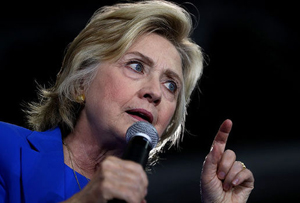Washington, Oct 12: Challenging her rival Donald Trump's assertion that climate change is a hoax, Democratic presidential nominee Hillary Clinton has asked Americans not to risk putting a "climate denier" in the White House.
 "We cannot risk putting a climate denier in the White House at all, that is absolutely unacceptable. We need a President who believes in science and who has a plan to lead America in facing this threat, creating good jobs and yes, saving our planet," she told her supporters yesterday at an election rally in Miami, Florida.
"We cannot risk putting a climate denier in the White House at all, that is absolutely unacceptable. We need a President who believes in science and who has a plan to lead America in facing this threat, creating good jobs and yes, saving our planet," she told her supporters yesterday at an election rally in Miami, Florida.
Clinton identified the US, Germany and China as the three countries which can be the clean energy superpower in the 21st century.
"The clean energy superpower of the 21st century are probably going to be either Germany, China, or us, and I want it to be us. And I want you to be part of making it us," she said as she detailed out her plans in this regard.
The 68-year-old ex-secretary of state was joined during her rally by former US Vice President and climate change leader Al Gore.
She argued that the US needs to accelerate the transition to a clean energy economy and create high paying jobs, building and installing more solar panels and wind turbines.
"Modernising electric grid, retrofitting buildings, building resilient, 21st century infrastructure, and the US has to make sure no community is left out or left behind.
"Now, you wouldn't know it if you only listened to my opponent talk about how terrible everything is," she said lashing out at her 70-year-old opponent.
"He has such a dark, divisive view of America, but that doesn't tell the story about what's really going on. It's actually pretty exciting. In red states and blue states, local leaders are stepping up," she said.
"Rural electric co-ops are investing in community solar power and you see that across America, union workers in Michigan, union workers in Michigan, are getting ready to build electric Chevys in a plant powered by clean energy. Iowa is already getting a third of its electricity from wind," she added.
"Wind turbines are going up in New England and on Lake Erie. Renewable energy is already the fastest-growing source of new jobs in America. I think that is so exciting. There are nearly two million people already working in energy efficiency," she noted.
Clinton said as President, she wants the US to have 500 million solar panels installed across America by the end of her first term. "And let's generate enough renewable energy to power every home in America within the decade. Let's make our buildings and factories more energy efficient and cut our oil consumption by one-third," she said.
"And we can get there by investing in cutting edge research to keep developing cheaper and better clean energy technologies, investing in clean energy infrastructure and advanced manufacturing, putting big partnerships together between states, cities and rural communities," she added.
"Donald Trump is, quote, 'not a big believer' in climate change. As I said, he said it's a hoax created by the Chinese. And in our first debate two weeks ago, he tried to deny saying that. But that tweet is still there for everyone to see," Clinton said referring to a tweet by the real estate baron in 2012.
Addressing the meeting, Al Gore asserted that with Clinton in the White House, the US will build on the progress made under Barack Obama with the Paris Agreement and she will seize the opportunities. "After all, solar electricity and wind electricity is now way cheaper than it was years ago when some of us started sounding the alarm about this crisis," he said.
"Almost 100 years ago, America's most famous inventor, Thomas Edison said these words -– it's an exact quote: 'I would put my money on the sun and solar energy. What a source of power. I hope we don't have to wait until the oil and coal come out before we tackle that.' Now, I want to say a brief word -– I'm going to return to my second main point here in a minute, but I want to say a brief word about something else that all of you can do. You can elect Patrick Murphy to the United States Senate instead of a climate denier," Gore said.





Comments
Add new comment